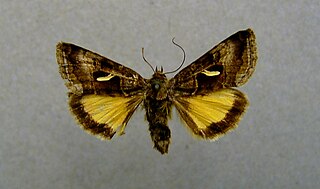
Lucilia cuprina, formerly named Phaenicia cuprina, the Australian sheep blowfly is a blow fly in the family Calliphoridae. It causes the condition known as "sheep strike"'. The female fly locates a sheep with ideal conditions, such as an open wound or a build-up of faeces or urine in the wool, in which she lays her eggs. The emerging larvae cause large lesions on the sheep, which may prove to be fatal.

Aglossa cuprina, the grease moth, is a snout moth, family Pyralidae, described by Philipp Christoph Zeller in 1872. The grease moth is closely related to the genus Pyralis, and as a result, is usually associated with the meal moth, Pyralis farinalis.
Antimimistis is a genus of moths in the family Geometridae.

Syngrapha hochenwarthi is a moth of the family Noctuidae. It is found in the Alps, the mountainous areas of Northern Norway and Finland, the Ural Mountains, the Balkan, the Caucasus and the Altai Mountains.

Aglossa is a genus of small moths belonging to the family Pyralidae. It was described by Pierre André Latreille in 1796. They are found mainly in western Eurasia, though some species have been introduced elsewhere.

Eupitheciini is a tribe of geometer moths under subfamily Larentiinae, often referred to as pugs. The tribe was described by Tutt in 1896.
Phrixia is a genus of beetles in the family Buprestidae, containing the following species:
Psyrassa is a genus of beetles in the family Cerambycidae, containing the following species:

Antimimistis attenuata is a moth in the family Geometridae. It is found in Sri Lanka, north-eastern Himalaya, Borneo, Sulawesi, Seram and New Guinea. Records from Queensland refer to Antimimistis illaudata which is sometimes listed as a synonym of Antimimistis attenuata.
Antimimistis illaudata is a moth in the family Geometridae. It is found in Queensland, Australia.
Antimimistis subteracta is a moth in the family Geometridae. It is found in India.
Thiomonas cuprina is an As(III)-oxidizing bacterium from the genus Thiomonas. It is proposed to be reclassified, along with Thiomonas arsenivorans, as strains of Thiomonas delicata.
Thiomonas delicata is an As(III)-oxidizing, nonmotile bacterium from the genus Thiomonas. Colonies of T. delicata are whitish-yellow in color.
Cuprina fuscella is a moth in the Stathmopodidae family. It was described by Sinev in 1988. It is found in Austria and eastern Siberia.
Bebelis cuprina is a species of beetle in the family Cerambycidae. It was described by Belon in 1903.

Lagria cuprina is a species of beetles in the family Tenebrionidae.
Isopsestis cuprina is a moth in the family Drepanidae. It was described by Frederic Moore in 1881. It is found in Tibet, India and Nepal.
Isopsestis is a genus of moths belonging to the subfamily Thyatirinae. The genus was described by Werny in 1968.

Stathmopodidae is a family of moths in the moth superfamily Gelechioidea described by Edward Meyrick in 1913.







